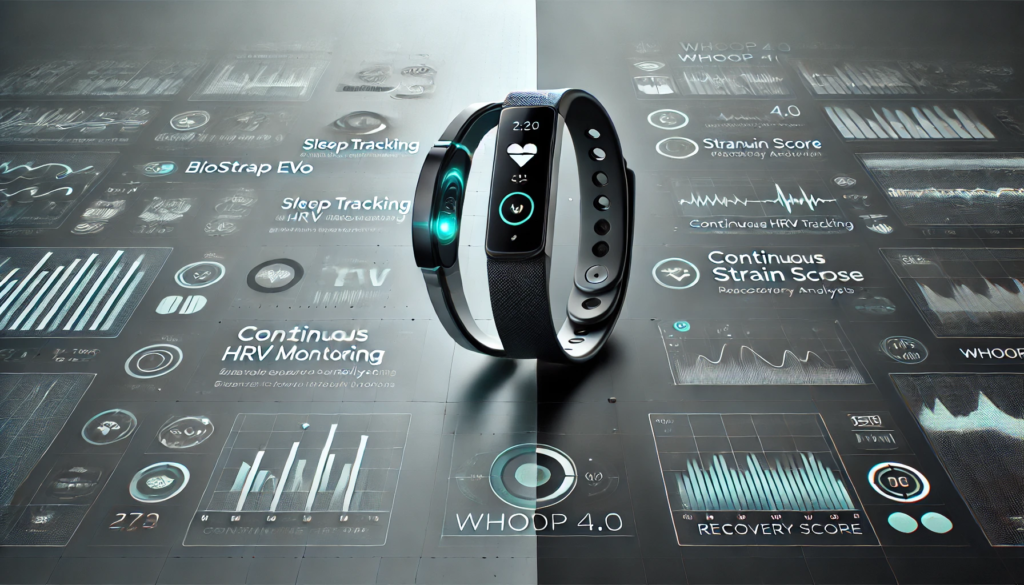
Introduction
In the world of fitness and health tracking, choosing the right device can make all the difference in optimizing performance, improving sleep, and gaining valuable insights into overall well-being. Two of the most advanced wearable devices on the market today are the Biostrap Evo and the Whoop 4.0.
Both trackers offer comprehensive data on sleep, recovery, and fitness, but they cater to slightly different users and have unique features that set them apart. In this article, we will compare the Biostrap Evo and the Whoop sleep and fitness tracker to determine which device is best suited for your needs.
Overview of Biostrap Evo and Whoop 4.0
Biostrap Evo
The Biostrap Evo is a sophisticated health and fitness tracker known for its clinical-grade biometrics. Designed to provide deep insights into heart rate variability (HRV), sleep quality, and fitness recovery, it is particularly popular among athletes, biohackers, and individuals focused on sleep optimization.
Key Features:
- Advanced sleep tracking with detailed sleep architecture analysis
- Heart rate variability (HRV) monitoring
- Blood oxygen saturation (SpO2) measurement
- Activity classification with over 100 exercises
- Resting heart rate (RHR) tracking
- Daily recovery score
- Auto-detection of movement and sleep
- Cloud-based AI analytics
Whoop 4.0
The Whoop 4.0 is a performance-driven fitness tracker designed for athletes and fitness enthusiasts. It focuses on providing real-time insights into strain, recovery, and sleep, helping users optimize training and prevent overexertion.
Key Features:
- Continuous heart rate and HRV monitoring
- Sleep tracking with sleep debt analysis
- Strain score for activity intensity measurement
- Recovery score based on HRV, RHR, and sleep
- Personalized coaching insights
- Skin temperature tracking
- Smart clothing integration
- No screen – designed for distraction-free tracking
Comparison of Biostrap Evo vs Whoop 4.0
1. Sleep Tracking Accuracy
Both Biostrap Evo and Whoop 4.0 offer detailed sleep tracking, but their approaches and accuracy levels differ.
Biostrap Evo: Biostrap takes a clinical approach to sleep tracking, analyzing sleep architecture (light, deep, and REM sleep) with high accuracy. It also monitors nocturnal HRV and SpO2 levels, providing an overall sleep score based on physiological signals.
Whoop 4.0: Whoop provides a sleep debt analysis, showing how much sleep you need based on previous nights. It tracks time in bed, wake disturbances, and sleep efficiency, offering actionable insights to improve sleep habits.
2. Recovery Monitoring
Recovery is crucial for optimizing performance and avoiding overtraining. Both devices use HRV, resting heart rate, and sleep data to assess recovery.
Biostrap Evo: Uses a daily recovery score based on biometrics like HRV, blood oxygen, and resting heart rate. The device provides insights into how well your body has recovered overnight.
Whoop 4.0: Offers a recovery score, which calculates HRV, RHR, and sleep quality to determine your readiness for the day. The score is color-coded (green = ready, yellow = moderate, red = low recovery) for quick assessment.
3. Fitness and Activity Tracking
Both trackers measure activity levels but focus on different metrics.
Biostrap Evo: Tracks over 100 exercises, including activities like weightlifting, swimming, and yoga. It focuses on movement quality rather than just exertion.
Whoop 4.0: Uses a strain score that quantifies how much stress your body has undergone during workouts. It does not track steps but rather the intensity and effort of activities.
4. Heart Rate Variability (HRV) & Heart Rate Monitoring
HRV is a critical metric for understanding recovery and overall health.
Biostrap Evo: Offers clinical-grade HRV tracking, capturing data at night when the body is in a resting state, ensuring accuracy.
Whoop 4.0: Measures HRV continuously throughout the day and night, offering real-time insights.
5. Wearability and Design
Both devices have sleek, minimalist designs, but their wearability differs.
Biostrap Evo: A small, lightweight band worn on the wrist. It includes an additional biometric pod that enhances data accuracy.
Whoop 4.0: A screenless strap that integrates with Whoop Body clothing for an unobtrusive experience.
6. Subscription and Pricing
Cost plays a big role in deciding between these trackers.
Biostrap Evo: Requires a one-time purchase for the device with optional premium subscription features.
Whoop 4.0: Operates on a subscription-based model, where you pay a monthly or yearly fee to access data.
7. Battery Life
Battery life impacts usability, especially for continuous tracking.
Biostrap Evo: Lasts 3-4 days per charge, depending on usage.
Whoop 4.0: Lasts 4-5 days and features an on-the-go battery pack for charging without removing the band.
Which One Should You Choose?
If you prioritize detailed sleep analytics and biometrics, the Biostrap Evo is a solid choice. It offers clinical-grade tracking without a subscription fee, making it ideal for users focused on health optimization. However, if you want continuous HRV monitoring, detailed recovery insights, and a seamless wearable experience, the Whoop 4.0 is the better fit. Its intuitive strain and recovery scores make it appealing to athletes who want precise data for training adjustments.
Conclusion
Both the Biostrap Evo and Whoop 4.0 are excellent fitness and sleep trackers, each excelling in different areas. Your choice ultimately depends on your fitness goals, tracking preferences, and budget. Regardless of which device you choose, both provide valuable insights to help optimize performance and improve overall well-being.
